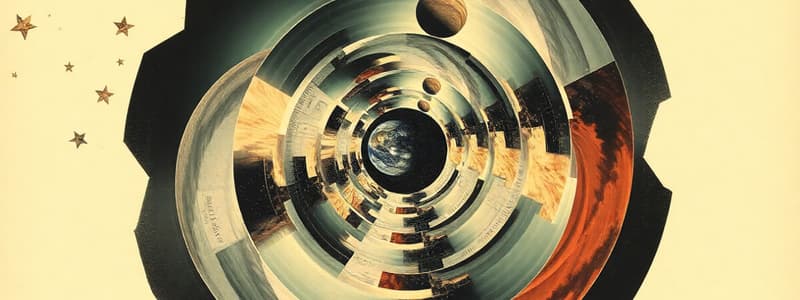Podcast
Questions and Answers
What is the relationship between torque, moment of inertia, and angular acceleration as defined in the content?
What is the relationship between torque, moment of inertia, and angular acceleration as defined in the content?
- Torque equals the moment of inertia divided by angular acceleration.
- Torque equals the square of the radius times angular acceleration.
- Torque equals the moment of inertia times angular acceleration. (correct)
- Torque equals the force times the distance from the axis of rotation.
How can weightlessness be experienced inside the International Space Station?
How can weightlessness be experienced inside the International Space Station?
- Through constant free fall. (correct)
- By using anti-gravity technology.
- By moving at high speeds in a straight line.
- By being millions of miles from Earth's gravitational influence.
What does the term 'moment of inertia' refer to in the context of rotational motion?
What does the term 'moment of inertia' refer to in the context of rotational motion?
- The force required to rotate an object at a constant speed.
- The quantity that determines an object's resistance to angular acceleration. (correct)
- The total mass of an object in motion.
- The distance from the center of mass to the point of rotation.
Which of the following correctly describes the force acting on a mass rotating at a distance 'r' from the axis of rotation?
Which of the following correctly describes the force acting on a mass rotating at a distance 'r' from the axis of rotation?
Which equation represents the definition of torque when considering a mass rotating at a distance 'r'?
Which equation represents the definition of torque when considering a mass rotating at a distance 'r'?
What is the primary purpose of artificial gravity in space stations?
What is the primary purpose of artificial gravity in space stations?
Which equation represents the relationship between linear velocity, centripetal acceleration, and radius in creating artificial gravity?
Which equation represents the relationship between linear velocity, centripetal acceleration, and radius in creating artificial gravity?
What negative effects can prolonged weightlessness cause that artificial gravity aims to alleviate?
What negative effects can prolonged weightlessness cause that artificial gravity aims to alleviate?
In a rotating space station, what does the centripetal acceleration at the outer rim equal?
In a rotating space station, what does the centripetal acceleration at the outer rim equal?
What is the angular velocity of a satellite if the radius is 1500 m and the artificial gravity is 9.8 m/s²?
What is the angular velocity of a satellite if the radius is 1500 m and the artificial gravity is 9.8 m/s²?
Which of the following is NOT a difficulty faced by astronauts in a rotating space station?
Which of the following is NOT a difficulty faced by astronauts in a rotating space station?
What is the time period for one rotation for a satellite with a radius of 1500 m under artificial gravity of 9.8 m/s²?
What is the time period for one rotation for a satellite with a radius of 1500 m under artificial gravity of 9.8 m/s²?
If the frequency of a satellite is 0.01286 Hz, what is the corresponding time period?
If the frequency of a satellite is 0.01286 Hz, what is the corresponding time period?
Which formula correctly relates the linear and angular velocity of a satellite?
Which formula correctly relates the linear and angular velocity of a satellite?
What will happen to the frequency of a satellite if the radius increases while the artificial gravity remains constant?
What will happen to the frequency of a satellite if the radius increases while the artificial gravity remains constant?
Flashcards
Torque
Torque
The twisting force that causes rotational acceleration.
Moment of Inertia
Moment of Inertia
A measure of an object's resistance to changes in its rotational motion.
Angular Acceleration
Angular Acceleration
The rate at which an object's angular velocity changes over time.
Torque Equation (4.23)
Torque Equation (4.23)
Signup and view all the flashcards
Weight in Space
Weight in Space
Signup and view all the flashcards
Weightlessness
Weightlessness
Signup and view all the flashcards
Free-Fall
Free-Fall
Signup and view all the flashcards
Space Stations
Space Stations
Signup and view all the flashcards
International Space Station (ISS)
International Space Station (ISS)
Signup and view all the flashcards
Artificial Gravity
Artificial Gravity
Signup and view all the flashcards
Centripetal Acceleration
Centripetal Acceleration
Signup and view all the flashcards
Linear Velocity (v)
Linear Velocity (v)
Signup and view all the flashcards
Radius (R)
Radius (R)
Signup and view all the flashcards
Artificial Gravity Equation
Artificial Gravity Equation
Signup and view all the flashcards
Weightlessness in space
Weightlessness in space
Signup and view all the flashcards
Effects of weightlessness
Effects of weightlessness
Signup and view all the flashcards
Angular Velocity (ω)
Angular Velocity (ω)
Signup and view all the flashcards
Linear Velocity (v)
Linear Velocity (v)
Signup and view all the flashcards
Relationship v = ωR
Relationship v = ωR
Signup and view all the flashcards
Satellite's Angular Velocity (ω)
Satellite's Angular Velocity (ω)
Signup and view all the flashcards
Satellite's Time Period (T)
Satellite's Time Period (T)
Signup and view all the flashcards
Satellite's Frequency (f)
Satellite's Frequency (f)
Signup and view all the flashcards
Artificial Gravity
Artificial Gravity
Signup and view all the flashcards



